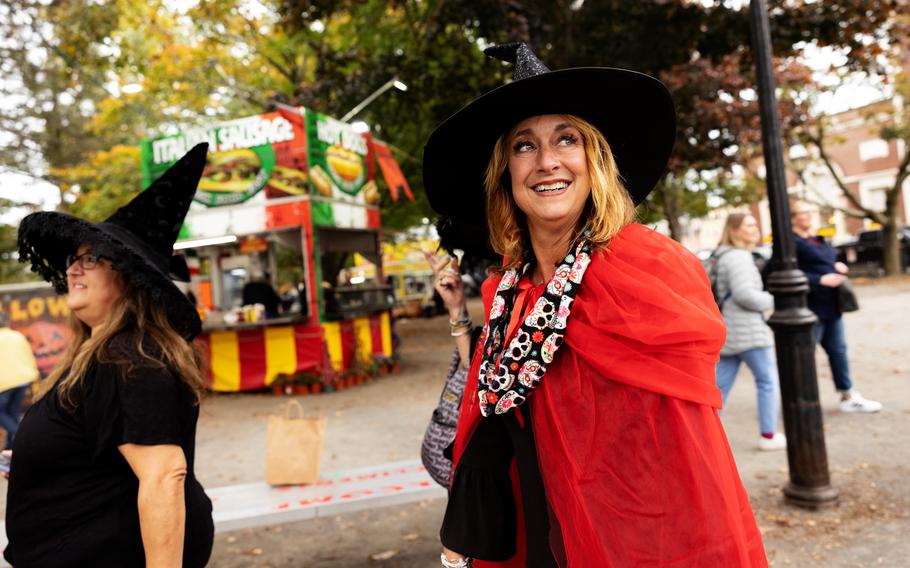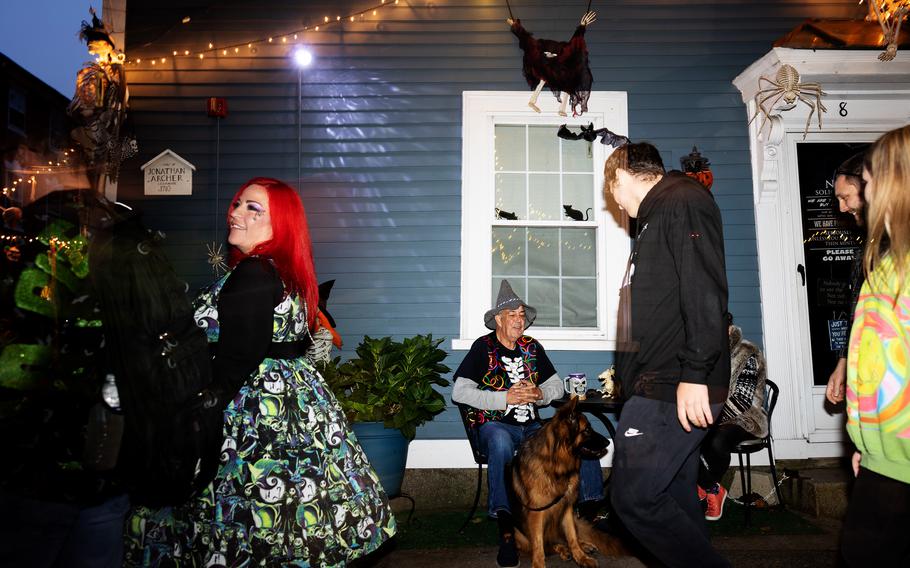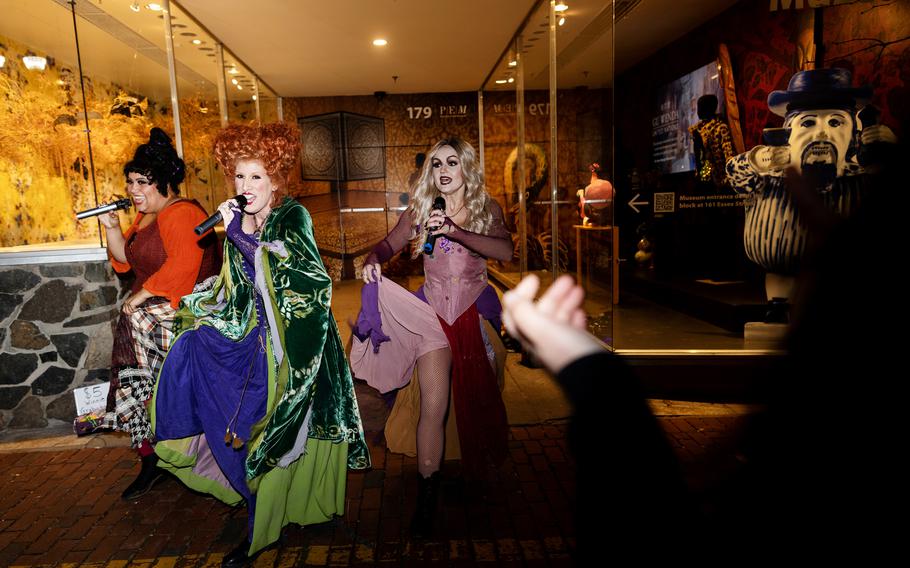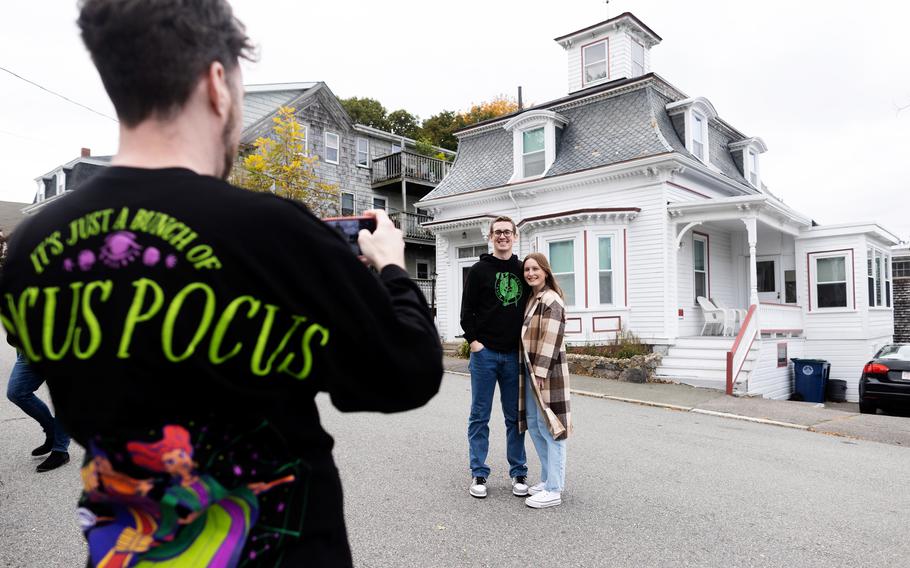
Witch enthusiasts Mellissa Campo, left, and Tammie Cash visit Salem, Mass., from Rhode Island. Last October, Salem welcomed more than 900,000 tourists — about 20 times the city’s population, according to a U.S. Census estimate. (Katye Martens Brier/For The Washington Post)
SALEM, Mass. — Driving into Witch City, U.S.A., you can’t help but notice the people in costumes pouring out of the train station. Many wear pointy hats. Some wear all black. Others carry brooms or cosplay in head-to-toe “Hocus Pocus” outfits. Over the past two years especially, fall tourism in Salem has grown so rapidly that every weekend in October feels like Halloween.
“This is a bucket-list trip for a lot of people. ... People plan this kind of thing sometimes well over a year in advance if they’re smart about it,” said Daniel Fury, who owns Black Cat Tours and the related Black Cat Curiosity Shoppe with his wife, Lara.
Last October, Salem welcomed more than 900,000 tourists — about 20 times the city’s population, according to a U.S. Census estimate. According to the state government, tourism in Salem generates more than $140 million a year in local spending. Many travel to partake in the city’s massive, family-friendly October festival, Haunted Happenings, which features walking tours, a parade, a “haunted” street fair and other Halloween-inspired events. Started in 1982, the citywide festival has grown from a weekend event to a month-long ordeal.
Salem leaders saw the city’s history as an opportunity to lay claim to the haunted season, said Emerson Baker, a history professor at Salem State University, “and it’s grown and grown and grown.”
“Come September 1st, it’s kind of like a gun goes off in some place, and the tide of Haunted Happenings mayhem starts,” said Richard Lindeman, president pro tempore of the preservation organization Historic Salem.
Known for its infamous 17th-century witch trials, Salem is now synonymous with witchy kitsch. In the process, the U.S. obsession with spooky season has overshadowed the tragic history in this coastal New England city. Although Salem’s transformation into a fall destination has been lucrative, it has also created conflict for locals who can’t access basic services.
Forget about driving
When I arrived in Salem one morning earlier this month, it seemed like the scariest part of my visit would be the hunt for parking. I spent nearly an hour in standstill traffic. No wonder Salem Mayor Dominick Pangallo told visitors to “come by bike, come by broom,” but don’t drive. I tried five lots before I could find somewhere to park for the day that wasn’t prohibitively expensive.
Salem wasn’t built to support an influx of some 700,000 people in a single weekend. Sheila Kelly Lawler, a retired optician and longtime Salem resident, said the city had to add internet infrastructure near her downtown neighborhood to better support the massive crowds. Like other Salem residents, she won’t be moving her car for the entire month of October because of the constraints on parking.
“Local citizens feel they’re living in a fishbowl,” Baker said, “especially in October.”
The massive boom in travelers poses safety risks and challenges for the small oceanside city. According to Patch, Salem Police Chief Lucas Miller said in a news conference this month that the city has to create the equivalent of a “second police department” every year to be able to respond to the needs of travelers and locals.
Lawler, whose family has lived in the same Salem house since 1955, said that, by the first week of October, she had already met visitors coming from as far as Rome and Arkansas. Although some locals prefer to escape to family homes in Maine or elsewhere during the entirety of October, Lawler puts up extravagant Halloween decorations and spends her days on her front porch talking to travelers.
Her neighbor Don Arnell takes a similar attitude. The sheer amount of tourists isn’t an issue “if you embrace it,” he said. “We enjoy the tourists. The more the better. Bring it on.”

Don and Anita Armell (and dog Olive) greet passersby. The sheer amount of tourists isn’t an issue “if you embrace it,” Don said. “We enjoy the tourists. The more the better. Bring it on.” (Katye Martens Brier/For The Washington Post)
Bachelorette party energy
Crow Haven Corner is the city’s oldest spooky store. Founded in 1970 by Laurie Cabot, “Salem’s official witch,” it’s now surrounded by similar shops downtown such as Omen, which sells prepackaged spells and spell candles.
At Black Cat Curiosity Shoppe, I found a line stretching around the block and an employee in a pumpkin-patterned kimono working the velvet rope at the door. In front of me, a group of six women wearing custom-made “GIRLS TRIP Salem, Massachusetts” T-shirts planned out their day. They weren’t the only group flaunting custom T-shirts reminiscent of Nashville bachelorette parties. That evening, they would shell out $30 each for a ghost trolley ride through the historic district.
Inside Black Cat, customers are greeted by shelves advertising seemingly exotic “curiosities,” including Indigenous Guatemalan “worry dolls” ($5), Tibetan-inspired prayer beads made from “yeti bone” ($13) and “mythical meat” jerky allegedly made from chupacabra, basilisk and gremlin ($3).
Other Salem stores peddle merchandise more overtly tied to pop culture, selling rows upon rows of “authentic” black felt witch hats, Frankenstein masks, broomsticks and “Hocus Pocus” ephemera.
“There’s no denying that the media, TV [and] movies have had a huge hand in crystallizing the American vision of what a witch is,” said Julie Walsh, a history of philosophy professor at Wellesley College who studies the Salem witch hunts. “In the American imagination, we have the sort of young, perennially beautiful, sexy witch and the old hag. And I think the way that Salem has curated its image has really continued to concretize and formalize those two poles.”

Performers from Orlando as the Sanderson sisters: Jennica McCleary as Winnie, center, Bebe Caliber as Sarah, right, and Dayja Le’Chelle as Mary. Salem hosts a massive, family-friendly, month-long October festival, Haunted Happenings, which features walking tours, a parade, a “haunted” street fair and other Halloween-inspired events. (Katye Martens Brier/For The Washington Post)
Monetizing a dark past
The Salem witch trials took place during a time of widespread panic and paranoia. Between early 1692 and mid-1693, more than 200 people in colonial Salem Town and Salem Village (modern-day Danvers) were accused of practicing witchcraft. The trials were fueled by a confluence of factors: religious extremism, xenophobia, sexism and the active and violent expulsion of Indigenous communities in the area. Nineteen people — 14 women, and five men — were hanged after being convicted of witchcraft.
Though the trials may seem superstitious and foolish from today’s point of view, the scapegoating at its core is familiar. According to Baker, who studies witchcraft in colonial New England as a sociological phenomenon that reflects the anxieties of Puritan English colonizers: “Every generation in American history has its Salem moment.”
The city’s somber history contrasts starkly with its month-long Halloween party.
“Even if one brings a spirit of reverence and somber spirit to that memorial space, it’s really hard to inhabit that spirit with the carnival happening around you,” Walsh said.
According to Baker, people need to understand the more nuanced facts of Salem’s history and how it affects the ethics of tourism there.
“The people who died were not witches. They had not harmed anybody. They were innocent. And, to some degree, there’s the question of how appropriate it is for the city to make a lot of money collectively off of the deaths of these poor innocent people,” he said.
Though there’s no real connection between Halloween and those who were considered witches — and, “frankly, there were no trials in October” — he sees events such as Haunted Happenings as a teachable moment.
Although the true, dark history of the Salem witch trials brings visitors to the city and gives weight to the city’s commercial Halloween monopoly, it’s also a history that continues evolving. The witch trials took place in the late 17th century, but it was only last year that the last convicted “witch” was finally exonerated.
There’s “always a dichotomy and tension between what we would call cultural tourism that embraces our history and much of the historic properties in Salem, versus nowadays Haunted Happenings and a big push for Halloween things,” said Lindeman, of Historic Salem.

Visitors pose in front of the “Hocus Pocus” house, which looks just as it did when the Sanderson sisters paid their visit to Salem. (Katye Martens Brier/For The Washington Post)
‘Hocus Pocus’ vs. real history
Elizabeth Montgomery, all dressed up in her “Bewitched” outfit as Samantha, has looked over visitors to a crowded Salem square since 2005. The bronze statue, which has since become a Salem landmark, features the actress sitting delicately on a broomstick, framed by a crescent moon.
Elsewhere, the house from the Disney movie “Hocus Pocus” towers over the Salem shoreline. During my visit, a long row of parked cars interrupted the otherwise tranquil, residential scene as tourists ran to take their pictures outside the private residence, which looks just as it did when the Sanderson sisters paid their visit to Salem.
When I walked into a witch bookstore, its shelves lined with books on moon lore and love charms, I overheard the cashier tell a customer that real witches in Salem don’t appreciate the “Hocus Pocus” attention.
“They give witches a bad reputation with the whole eating children thing,” she said.
Many of the (supposedly) occult stores downtown also advertise love spells and crystals with healing properties. At Pentagram Witchcraft & Magick Shoppe, just opposite a somber memorial for the witch trials, a 15-minute tarot read sells for $50.
The result is that now, in Salem, “you can’t really tell what’s real and what isn’t,” Baker said.
For example, there are plenty of cemeteries scattered throughout the city that feign a connection to the witch trials and colonial Salem. Only the Charter Street Cemetery, however, is “the real 17th-century cemetery for the city,” Baker said. The others are newer.
Many of the most popular tours in the city are “Hocus Pocus” location tours or ghost tours that cater to the Halloween crowds. Daniel Fury, who manages the tour side of the Black Cat operation, believes that these tours can be a positive force as long as they remain connected to the real history of Salem and the surrounding areas.
“The more we dig into history, the more people want to know ... especially if it’s different from the misinformation they’ve heard for years,” he said.
Many travelers falsely believe that those persecuted as witches were burned at the stake, for example, when, in reality, they were hanged.
“Salem represents a really interesting tapestry of contradictions when it comes to honoring the past,” Walsh said. She compared the reaction she had when she first visited the city to the reaction she had when visiting Niagara Falls, where she found “gaudy shops” and “all this terrible constructed commercialization.”
Like many towns in the area, Salem was an industrial city: By the early 19th century, its prosperous maritime trade had been replaced by leather factories and textile mills. It struggled economically at times because of it.
“Salem was a horrible factory town for many years,” said Fury, the shop owner and tour guide. “People who lived here in their youth remember that [and] understand that what we have now is better, but you don’t hear that very much.”
Just how ghost tourism has been shown to revitalize abandoned mill and mining towns in the Midwest, witch and Halloween lore brought Salem much-needed economic development. With a massive fire in 1914 and a heavily polluted river, Fury said, the city “had to come up with something to survive, and that’s what most cities do.”
The possibility remains, however, that the city traded one extractive industry for another.
“Halloween is an industry,” Walsh said. “You can’t lose sight of the money involved here. As it has become more and more pronounced in American culture, it has been really, really lucrative to promote these ideas of witches as costumes.”
The solution, she says, comes with finding “a balance between honoring the people brutalized [during the witch trials] and realizing that people today deserve a good living, and to live in a place with enough income and revenue to maintain themselves.” It’s important, Walsh added, “to go to Salem to see the choices that the town has made to capitalize on this event.”
Polly Wilbert, treasurer at Historic Salem, advocates for more intentional Salem travel outside the Halloween months. During other parts of the year, visitors can learn about Salem’s long and varied history without the consumerism and crowds of October.
“We’re proud of the fact that we have such a deep and rich and interesting number of things to see and do in Salem that’s open 12 months,” she said.